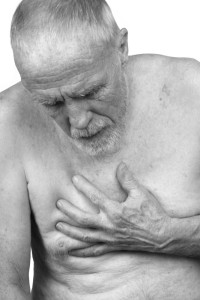About 2/3 of patients have the beginnings of symptoms of a heart attack, namely shortness of breath or fatigue days or weeks before the heart attack. Then suddenly they have a deep pain under the chest bone which is perceived as an ache or pressure and often radiates to the back, the jaw or the left arm. It is very similar to the pain perceived with angina, but it lasts longer, is more severe and does not respond to nitroglycerine. The patient is restless, looks pale and the skin feels cool and may look bluish (the medical term for this is “cyanotic”). The important part for the family members or the people around the patient is to call 911 and indicate your suspicion that the person has a heart attack. The ambulance will soon arrive. Should the person pass out and get into shock it is important to apply CPR right away. The sooner CPR is applied, the better the chances of survival for the patient.
References:
1. DM Thompson: The 46th Annual St. Paul’s Hospital CME Conference for Primary Physicians, Nov. 14-17, 2000, Vancouver/B.C./Canada
2. C Ritenbaugh Curr Oncol Rep 2000 May 2(3): 225-233.
3. PA Totten et al. J Infect Dis 2001 Jan 183(2): 269-276.
4. M Ohkawa et al. Br J Urol 1993 Dec 72(6):918-921.
5. Textbook of Primary Care Medicine, 3rd ed., Copyright © 2001 Mosby, Inc., pages 976-983: “Chapter 107 – Acute Abdomen and Common Surgical Abdominal Problems”.
6. Marx: Rosen’s Emergency Medicine: Concepts and Clinical Practice, 5th ed., Copyright © 2002 Mosby, Inc. , p. 185:”Abdominal pain”.
7. Feldman: Sleisenger & Fordtran’s Gastrointestinal and Liver Disease, 7th ed., Copyright © 2002 Elsevier, p. 71: “Chapter 4 – Abdominal Pain, Including the Acute Abdomen”.
8. Ferri: Ferri’s Clinical Advisor: Instant Diagnosis and Treatment, 2004 ed., Copyright © 2004 Mosby, Inc.
9. The Merck Manual, 7th edition, by M. H. Beers et al., Whitehouse Station, N.J., 1999. Chapters 197, 202, 205 and 207.
10. Marx: Rosen’s Emergency Medicine, Chapter 76 – Acute Coronary Syndrome; spectrum of disease. 7th ed. copyright 2009 Mosby, An Imprint of Elsevier
11. http://www.ncbi.nlm.nih.gov/pubmed/19891279 : Cziraky MJ, Watson KE, Talbert RL: “Targeting low HDL-cholesterol to decrease residual cardiovascular risk in the managed care setting.” J Manag Care Pharm. 2008 Oct;14(8 Suppl):S3-28; quiz S30-1.
12. http://www.ncbi.nlm.nih.gov/pubmed/23029021 : Hoevenaar-Blom MP, Nooyens AC, Kromhout D, Spijkerman AM, Beulens JW, van der Schouw YT, Bueno-de-Mesquita B, Verschuren WM: “Mediterranean Style Diet and 12-Year Incidence of Cardiovascular Diseases: The EPIC-NL Cohort Study.” PLoS One. 2012;7(9)
13. http://www.ncbi.nlm.nih.gov/pubmed/20236088 :Shecterle LM, Terry KR, St Cyr JA.: “The patented uses of D-ribose in cardiovascular diseases.” Recent Pat Cardiovasc Drug Discov. 2010 Jun;5(2):138-42.
14. http://www.ncbi.nlm.nih.gov/pubmed/19200398 : Sawada SG, Lewis S, Kovacs R, Khouri S, Gradus-Pizlo I, St Cyr JA, Feigenbaum H. “Evaluation of the anti-ischemic effects of D-ribose during dobutamine stress echocardiography: a pilot study.” Cardiovasc Ultrasound. 2009 Feb 7;7:5.
15. http://www.ncbi.nlm.nih.gov/pubmed/22040938 : Ferreira JC, Mochly-Rosen D. “Nitroglycerin use in myocardial infarction patients.” Circ J. 2012;76(1):15-21.
16. http://www.ncbi.nlm.nih.gov/pubmed/21530799 : Zand J, Lanza F, Garg HK, Bryan NS. “All-natural nitrite and nitrate containing dietary supplement promotes nitric oxide production and reduces triglycerides in humans.” Nutr Res. 2011 Apr;31(4):262-9.
17. http://www.ncbi.nlm.nih.gov/pubmed/22821988 : Christou DD, Pierce GL, Walker AE, Hwang MH, Yoo JK, Luttrell M, Meade TH, English M, Seals DR. “Vascular smooth muscle responsiveness to nitric oxide is reduced in healthy adults with increased adiposity.” Am J Physiol Heart Circ Physiol. 2012 Sep;303(6):H743-50.







